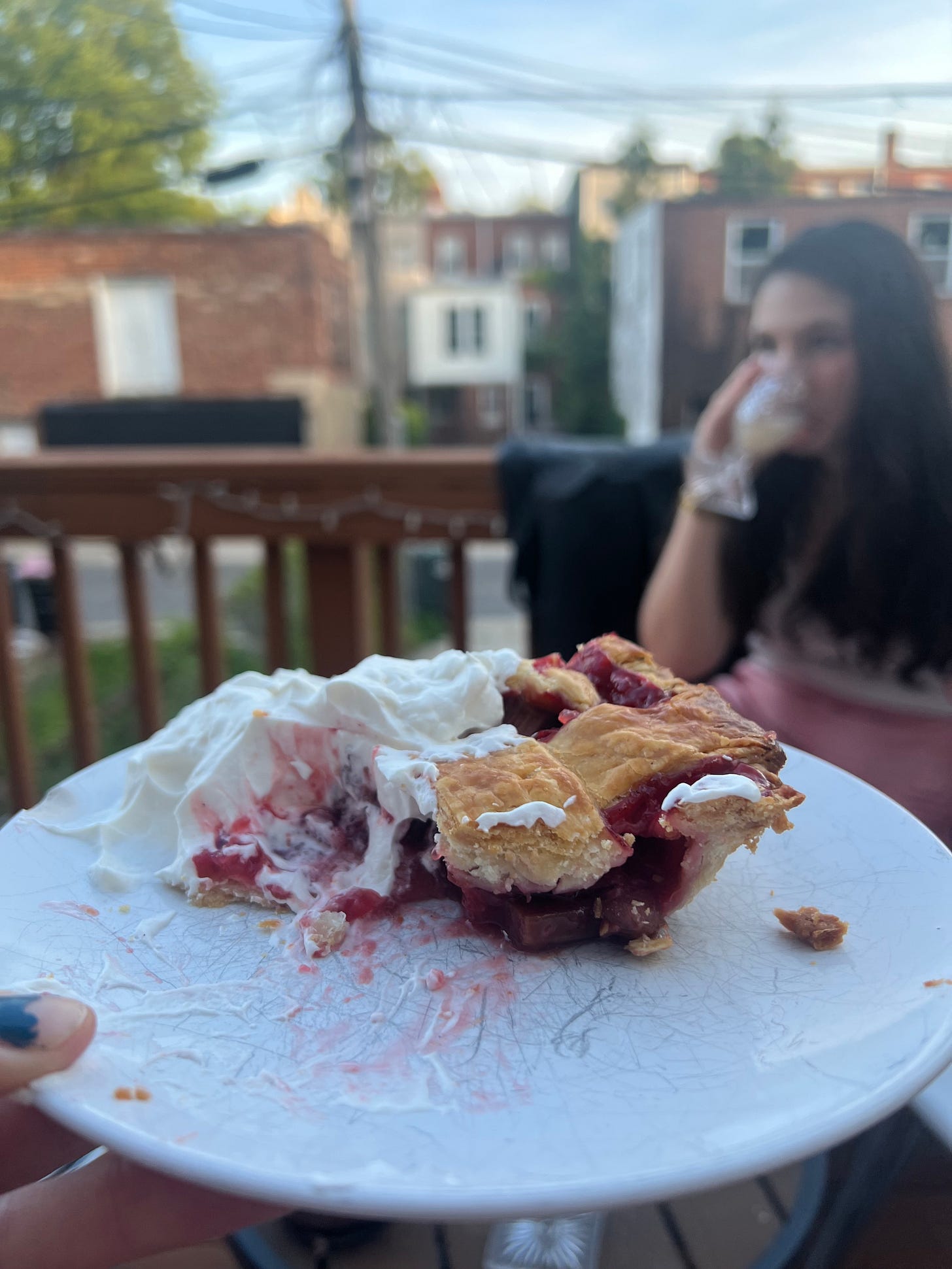everyone should make a pie
a perfect pie crust, and the fleeting strawberry rhubarb season
It’s the end of a gorgeous weekend and the last few hours of Mother’s Day, one of the few kitschy holidays I adore because I so rarely remember to just be sweet and make it about my mom, as it should be. This newsletter is dedicated to her, as the woman who taught me not to overwork the pie dough, whatever else you do. The first time she was impressed with my pie crust was a huge fucking win for me. (Instructions for making a crust that can wow even my exacting mother can be found at the bottom of this newsletter).
It was May of 2020, I was living in the outer hills of San Francisco with a kind but darkly quirky quasi-uncle, and I was bored. I was in love with the salty morning fog and the surprising afternoon sun and less in love with the total absence of humanity that defined the city then (and from what I hear, has ever since).
Every weekend, I entertained myself by wandering down the winding, hilly roads without my phone, getting lost and then found again and gaping at the overflowing lemon trees and artichoke plants that counted as landscaping (I eventually progressed to stealing the fruits that everyone seemed content to just let rot on the plants). At the bottom of one of the hills, I walked into a wash of air redolent with an ambrosia-like perfume. I had found one of San Francisco’s iconic farmer’s markets in the peak of apricot season, when the apricots are so ripe and so prone to bruises that they release an intense aroma that lingers in the air where they are sold.
The first time I ate one of those apricots, a fruit I had previously dismissed as a poor and mealy imitation of a peach, it was like biting into an explosive ball of concentrated, complicated syrup. With those apricots, I actually internalized for the first time that seasonal produce, grown in the climate where it’s really meant to be found, can taste so overwhelming that it transcends the depression of being alone in a new place during a pandemic. That apricot-loaded air became a drug for me. I can smell it now, three years later as I sit here writing.
Then it was cherries, and peaches and nectarines, plums, kumquats, and figs. I started to make myself sick stuffing my face on fruit. I spent so much of the little money I had in a sort of crazed revelry. Eventually, I had to find something else to do with the fruit. And so during those four months outside of time, I started to make pies.
I made multiple pies a week. The daughter of my host, visiting for a couple of weeks, went from acquaintance to fast friend at some point around pie number six. I also made the pie crusts, and I justified the glut of pies as necessary excess in my quest to perfect the crust.
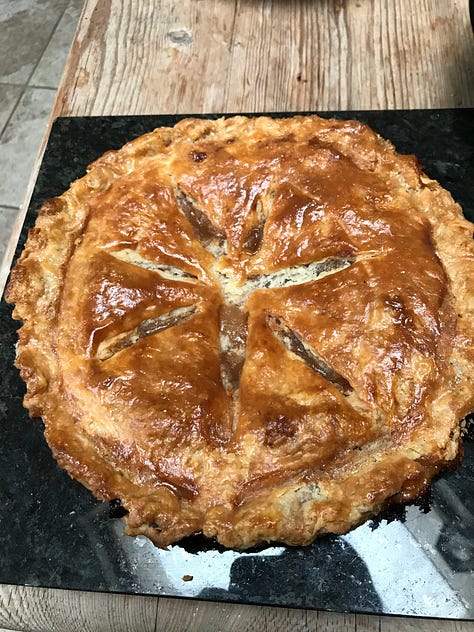
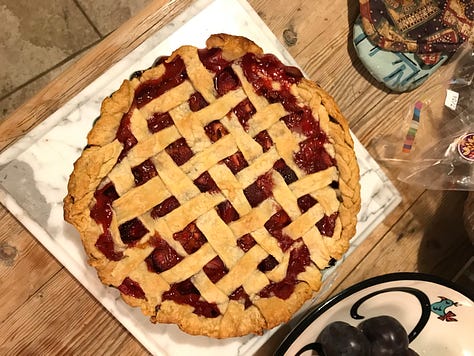

That takes us to the point of today’s newsletter, and to the strawberry-rhubarb pie I made this morning. Strawberries and rhubarb are both in season right now here in Washington, D.C., and they’ve only got a few more weeks of seasonality on the East Coast. They are an impeccable combination in the peak of the season, the strawberries tiny and sugar-sweet, the rhubarb a tear-inducing sour. It’s a classic pie for a reason, and one you should make this week while you have the chance. Strawberries won’t be this good in a couple of weeks, and rhubarb you won’t find anywhere until next year.
A perfect pie should feature textured, juicy fruit reduced down to its essence and encased in a flaky, buttery, deeply-browned shell. Historically, American fruit pies are such a beloved dessert because at their best, they make a celebration of the flavors and textures of seasonal fruit. Most fruit pies you can find today don’t actually do that because the crust just disintegrates into the perfectly cooked fruit, turning everything to a one-note mush. This often happens, I am sorry to say, when you use a pre-made crust. You just can’t control what’s in those crusts. In order for the crust to retain its shape and texture when baked with fruit, it should have just four or five ingredients, manipulated as little as possible: flour, butter, water, salt, and sugar.
I promise, attaining an almost perfect crust by hand is so easy. I did it on attempt two or three in that era of San Francisco madness, and then I spent the next three and a half months striving for completely perfect, which does not exist unless you make pies every day of your life for years and years. Perfection in pie is a quest for the crazy person. Almost perfect is for anyone. The dough might be a little ugly or split when you try to roll it, but it will taste like buttery crunchy goodness.
And after you’ve done it a few times — breaking apart the butter into the flour, massaging with your hands until none of the flour feels like flour anymore, carefully folding in ice cold water until magically, when you press it all together, it holds — it becomes meditative. It’s you, and this crust, and your senses, and for fifteen minutes of your life you don’t have other thoughts, just the instinct deep inside that tells you when to stop handling the dough.
All of the cookbooks and recipes will instruct you to be careful not to overwork the dough, to be quick with your fingers, to keep the butter cold, and to use just enough water to hold it together, all of which is excellent and useful advice, all intended to prevent you from forming gluten (which makes the crust tough) and from melting the butter (which would prevent flakiness). But none of these cookbooks tell you that it isn’t hard. That these instructions are easy to follow. And that after you do it a couple of times, you won’t need them anymore, because your fingers will remember how it’s supposed to feel. They don’t tell you that it really does take just fifteen minutes once you get the hang of it.
Some quick housekeeping: A handful of you wonderful souls have pledged actual real money to fund this newsletter in the last week. Anytime I include the Subscribe button, Substack gives everyone who is already getting my emails the chance to pledge their financial support, should I choose to allow Substack to charge people’s credit cards. That is a power I am still frightened of, but I wanted to thank those of you who have made me realize it’s something I should consider.
So, my basic instructions for an all-butter pie crust:
If you’re looking for a detailed, proper pie crust recipe, I recommend the all-butter deluxe pie dough in the Joy of Cooking, or the version from, which includes a bit of vinegar to really reduce the risk of gluten formation. (Not something I do because I like to use as few ingredients as possible and don't have a gluten-formation issue, but it works!)
I use about 315 grams of all-purpose flour (weighing is easier and faster for me, but that’s 2.5 cups if you refuse to weigh), 1 teaspoon of salt, and 1 teaspoon of sugar. Whisk that together. Then take two sticks of cold butter (16 tablespoons total), cut them into cubes, and toss the cubes into the flour, tossing the whole thing to coat all the cubes in flour. Then, take your fingers and aggressively mash each cube of butter into the flour, pressing the butter very hard between your fingers and imagining you are making the cube into a flake. After you’ve done that once for most of the big cubes, you should suddenly turn very gentle, massaging the butter pieces into the flour as evenly as possible. Your hands are really in this bowl of flour. You are feeling around, ensuring that you can still feel butter chunks but also feeling that all of the flour has been coated with or seen the presence of butter.
Once you get to the point where you can see pieces of butter like big glass marbles, and pieces of butter like peas, you add ice cold water. It’s about 1/4 cup plus 3 tablespoons, but to be honest I haven’t measured in years. The amount of water needed by the dough depends on mysterious factors like the moisture in the air, the flour, and the butter, all of which changes day to day and makes the whole thing a guessing game. I just sorta dump some ice water on the dough, toss it all together VERY GENTLY with my hands, then dump a little more. (You are being gentle here because flour + water + pressure/manipulation = gluten, which you do not want).
Once you can take most of the dough and press it into a ball and it holds, you’re good. At that point, you separate the dough into two evenly-sized balls, pressing each one into a flat circle on a piece of plastic wrap, and wrap it up tightly (to prevent moisture from escaping). The dough needs to sit for a couple of hours in the fridge or overnight, in order to hydrate (allow the water to permeate more evenly throughout the flour) and to chill the butter (which allows for more flake when it bakes).

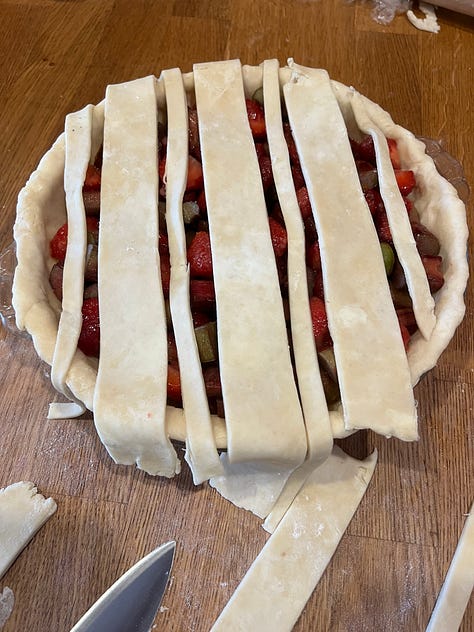
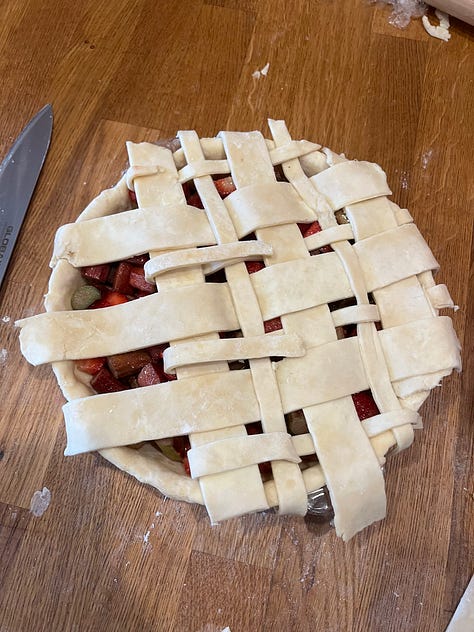
I’m not going to include detailed instructions on making the pie from here, because any pie recipe will do. A good fruit pie is just the fruit, some sugar, something acidic (lemon juice is best), salt, cornstarch or other thickener (I hear tapioca is great), and maybe a spice. But there are some things you can do to improve pie quality no matter what: use salt, taste the pie filling before you cook it, cook anything with a butter crust for at least 1.5 hours in the oven, let the pie cool for at least four hours to let the filling set, and serve with ice cream or whipped cream.
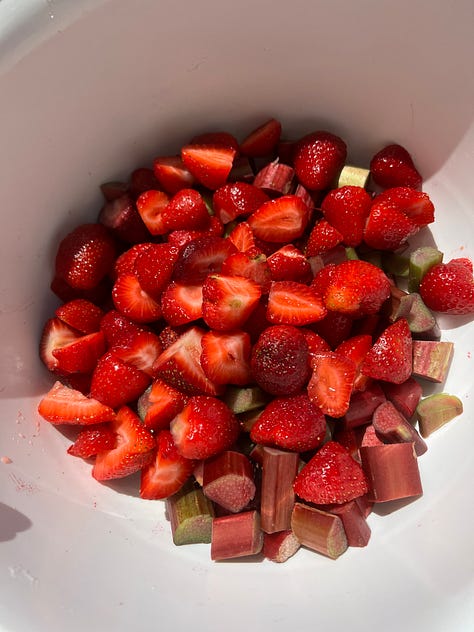
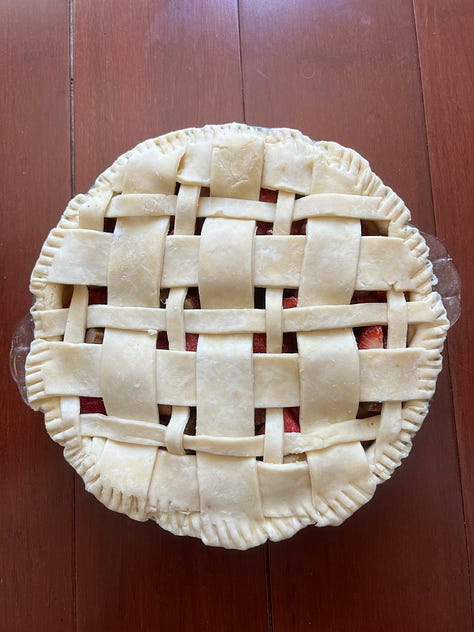
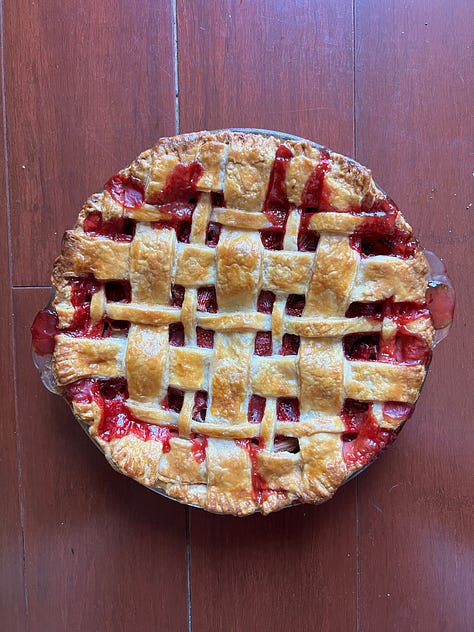
As long as you follow that basic formula and use a homemade crust + local, in-season fruit, your pie will be a little miracle.
Restaurant notes this week
juicy, perfect fried chicken: Dave’s Hot Chicken. Columbia Heights. This place has surprised me every time. The “sliders” are just hot chicken sandwiches, and they slap. The chicken is tender. The cole slaw is crunchy and fresh. The bun is a potato bun. The price is good.
Until next time, imagine if this mouthwatering slice of pie and cream were yours… And it could be.


